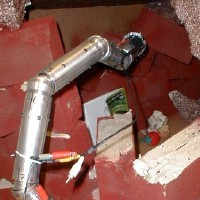Urban Search and Rescue (USAR) workers have 48 hours to find trapped survivors in a collapsed structure, otherwise the likelihood of finding victims still alive is nearly zero. Earthquake disaster mitigation requires rapid and efficient search and rescue of survivors. As recently seen in Turkey and Taiwan, the magnitude of the devastation of urban environments exceeds the available resources (USAR specialists, USAR dogs, and sensors) needed to rescue victims within the critical first 48 hours. Moreover, the mechanics of how large structures pancake often prevent heroic rescue workers from searching buildings due to the unacceptable personal risk from further collapse. Finally, and perhaps best addressed by the proposed work, both people and dogs are frequently too big to enter voids, limiting the search to no more than a few feet from the perimeter.
Serpentine mechanisms, on the other hand, have many more degrees of freedom than conventional robots and rescue machinery, while at the same time have a small cross-sectional area. These many degrees of freedom enable hyper-redundant mechanisms to thread through tightly packed volumes reaching locations otherwise inaccessible to conventional robots and people, while at the same time, not disturbing the surrounding areas. This is critical in search and rescue operations where large pieces of debris become fragile make-shift support structures.
Serpentine manipulators also offer unique forms of mobility particularly well-suited to confined areas. Consider their biological counterparts: snakes and worms. Snakes lost their legs in evolution because the legs got in the way when crawling through narrow passageways. Likewise, serpentine mechanisms can maneuver through narrow crawl spaces and then up a vent, etc. Just like their biological counterparts, these highly articulated mechanisms can also perform a variety of tasks — manipulation (spider monkeys and elephant trunks), locomotion (snakes and worms), shoring (teams of ants), inspections etc. — albeit not as well as a specialized mechanism for one task but sufficiently well for a variety. Finally, as their name suggests, hyper-redundant manipulators are redundant, so if one actuator fails, the mission can still achieve its goals.
The many degrees of freedom that furnish the serpentine mechanism with its wide range of capabilities also provides its major challenges: mechanism design, path planning / control, and sensor integration. The proposed work will develop a new sensor-rich serpentine mechanism using existing technology, and will explore the use of novel technologies, such as electro-polymers, for future designs. The mechanism, by itself however, is not enough — it needs sophisticated control algorithms. Current serpentine path planners are rudimentary at best; they are ad-hoc planar solutions that will not work in complicated environments. The effort will build upon the prior work in path planning to yield control paradigms for directing serpentine mechanisms through unknown three-dimensional spaces.
current head
current contact
past staff
- Doug Hull
- Jon Luntz
- Elie A Shammas

